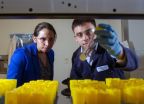(Press-News.org) Athens, Ga. – Developmental biologists at the University of Georgia are discovering new roles for a specific gene known as Max's Giant Associated protein, or MGA. A little studied protein, MGA appears to control a number of developmental processes, and also may be connected to cancer development.
The researchers detail their findings in a paper published recently in the journal Developmental Cell.
"The same genes that are involved in building a person during embryonic development can mutate and cause cancer later in life," said Scott Dougan the study's principal investigator and Georgia Cancer Coalition Distinguished Cancer Scientist in UGA's Department of Cellular Biology. "No one has done a systematic study of MGA, but now that some studies connect it to cancer, there is tremendous interest."
The most common cancer associated with MGA is chronic lymphocytic leukemia, a blood and bone marrow disease in which the body produces too many white blood cells. Preliminary tests suggest that this cancer might develop when MGA does not successfully control the activities of another protein known as MYC, which contributes to tumor growth.
Dougan and his team of researchers used their own methods to change the levels of MGA in the embryos of zebrafish to see if they could discover any other roles for MGA.
They found that MGA also helps control expression of the Bone Morphogenetic Proteins, or BMP, which, as the name implies, are responsible for bone development in the embryo. In adults, however, changes in BMP activity can result in tumor development, and MGA may be part of this detrimental transformation.
"Scientists are only beginning to understand the roles this MGA protein plays, but our tests show that MGA may control many more processes than first imagined," said Dougan, who is also a member of UGA's Developmental Biology Alliance. "MGA may be involved in a number of other cancers, but we need to do more research before we're sure."
In the coming months, Dougan and his research team plan to further examine the roles of MGA to determine when it controls MYC, when it controls BMP and how it is involved in tumor formation.
"This is basic science, and we need investigations like these to understand the fundamentals of our biology," Dougan said. "Once we have this understanding, we can begin to develop new therapies to treat diseases in new, more effective ways."
INFORMATION:
Other researchers on this project include Yuhua Sun, Wei-Chia Tseng, Xiang Fan and Rebecca Ball. A full copy of the paper in Developmental Cell is available at: http://www.cell.com/developmental-cell/abstract/S1534-5807(14)00026-4
Note to editors: An image of Dougan is available at http://multimedia.uga.edu/media/images/Dougan-Scott.jpg.
Writer: James Hataway, 706-542-5222, jhataway@uga.edu
Contact: Scott Dougan, 706-583-8194, dougan@uga.edu
UGA researchers explore function of cancer-causing gene
2014-03-26
ELSE PRESS RELEASES FROM THIS DATE:
History is made with first small LVAD implant for young muscular dystrophy patient
2014-03-26
DALLAS – March 26, 2014 – "Today, we're going to make history," said 18-year-old Eric Ramos on the day UT Southwestern Medical Center doctors operated on his ailing heart. Eric, who has Duchenne muscular dystrophy, is one of only three patients in the United States with the condition to receive a battery-operated left ventricular assist device (LVAD) to keep his weakening heart pumping blood through his body. He is the first patient in the country to be given a specific, smaller LVAD, which means doctors would not need to manipulate his diaphragm, which could compromise ...
Targeting enforcement where needed most in Africa's heart of biodiversity
2014-03-26
Scientists seeking a more efficient way of protecting the heart of Africa's wildlife—the Greater Virunga Landscape—have developed a method to make the most of limited enforcement resources, according to a new study by the Wildlife Conservation Society, the University of Queensland, Imperial College London, and the Uganda Wildlife Authority.
By channeling data on wildlife sightings and park guard patrolling routes into spatial planning software, conservationists have devised a cost-effective method for maximizing the deterrence effect of patrolling to protect Africa's ...
New Capsicum annuum pepper contains high concentrations of beneficial capsinoids
2014-03-26
ORONO, ME--Researchers have released a new Capsicum annuum pepper germplasm that contains high concentrations of capsinoids. The release was announced in the January 2014 issue of HortScience by researchers Robert L. Jarret from the USDA/Agricultural Research Service in Griffin, Georgia, in collaboration with Jason Bolton and L. Brian Perkins from the Department of Food Science and Human Nutrition at the University of Maine.
According to the report, the germplasm called "509-45-1" is a small-fruited Capsicum annuum L. pepper. Fruit of 509-45-1 contain high concentrations ...
AGU: New study shows major increase in West Antarctic glacial loss
2014-03-26
WASHINGTON, D.C. -- Six massive glaciers in West Antarctica are moving faster than they did 40 years ago, causing more ice to discharge into the ocean and global sea level to rise, according to new research.
The amount of ice draining collectively from those half-dozen glaciers increased by 77 percent from 1973 to 2013, scientists report this month in Geophysical Research Letters, a journal of the American Geophysical Union. Pine Island Glacier, the most active of the studied glaciers, has accelerated by 75 percent in 40 years, according to the paper. Thwaites Glacier, ...
Phloem production in Huanglongbing-affected citrus trees
2014-03-26
LAKE ALFRED, FL--Citrus Huanglongbing (citrus greening disease) is highly destructive and fast-spreading, contributing to a reduction in crop yields in Florida and threatening the future of the citrus industry worldwide. Once infected, trees never fully recover and there currently is no cure, although proper nutrient and water management appear to slow tree decline in some situations.
A bacterium called Candidatus Liberibacter asiaticus (CLas), vectored by the Asian citrus psyllid, is the presumed causal agent of the disease. Citrus trees affected by HLB exhibit a progressive ...
Study identifies key player in motor neuron death in Lou Gehrig's disease
2014-03-26
Amyotrophic lateral sclerosis, also known as Lou Gehrig's disease, is marked by a cascade of cellular and inflammatory events that weakens and kills vital motor neurons in the brain and spinal cord. The process is complex, involving cells that ordinarily protect the neurons from harm. Now, a new study by scientists in The Research Institute at Nationwide Children's Hospital points to a potential culprit in this good-cell-gone-bad scenario, a key step toward the ultimate goal of developing a treatment.
Motor neurons, or nerve cells, in the brain and spinal cord control ...
Repeat sternotomy for aortic valve replacement safe option for octogenarian patients
2014-03-26
Beverly, MA, March 26, 2014 – Surgical aortic valve replacement generally improves patients' symptoms and prolongs survival. However, the perceived risk of surgical aortic valve replacement in patients over 80 may result in surgery being denied or a recommendation for alternative therapy. Investigators at the Mayo Clinic challenge the way these patients have been managed. They report that repeat sternotomy in patients over 80 who have previously had coronary bypass graft surgery can be done with low risk. Their findings are published in the Journal of Thoracic and Cardiovascular ...
Prestorage conditioning, diphenylamine improve condition of 'honeycrisp' apple
2014-03-26
EAST LANSING, MI--Since the introduction of 'Honeycrisp' apples in 1991, the variety has become a consumer favorite for its unusual texture and delicious flavor. Honeycrisp has increased in popularity with growers as well; Michigan, New York, and Washington boast significant numbers of 'Honeycrisp' orchards. As the growing area dedicated to the variety has grown, the need to find better methods for improving storage performance has become more important to growers. Because 'Honeycrisp' is very sensitive to low temperatures and can be damaged by controlled-atmosphere conditions, ...
Nitrogen source determined significant for inflorescence development in Phalaenopsis
2014-03-26
TAIPEI, TAIWAN--The Phalaenopsis orchid, also known as the moth orchid, is the most important pot flower in terms of market value in the world's major floriculture markets. Because nitrogen significantly affects the growth and flowering of Phalaenopsis, nitrogen needs during flowering are of particular interest to growers. Researchers Hadi Susilo, Ying-Chun Peng, and Yao-Chien Alex Chang from the Department of Horticulture and Landscape Architecture at National Taiwan University published a study in the Journal of the American Society for Horticultural Science that determined ...
Engineered bacteria produce biofuel alternative for high-energy rocket fuel
2014-03-26
Researchers at the Georgia Institute of Technology and the Joint BioEnergy Institute have engineered a bacterium to synthesize pinene, a hydrocarbon produced by trees that could potentially replace high-energy fuels, such as JP-10, in missiles and other aerospace applications. With improvements in process efficiency, the biofuel could supplement limited supplies of petroleum-based JP-10, and might also facilitate development of a new generation of more powerful engines.
By inserting enzymes from trees into the bacterium, first author and Georgia Tech graduate student ...



